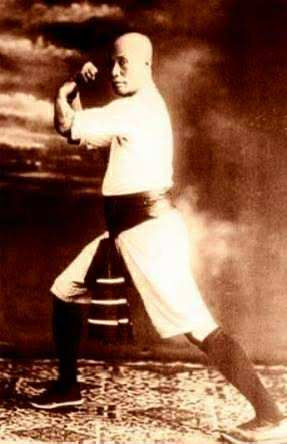Why Wushu Sport is not real Kung Fu: The truth behind China's Martial Arts suppression
- Lee McGeough

- 13 hours ago
- 4 min read
If you’re considering learning martial arts, or you're a kung fu student seeking clarity on the difference between traditional Chinese martial arts and modern Wushu sport, this post is for you.
There’s a lot of misinformation online - some of it well-meaning, some of it not! It's useful to outline the fact from the fiction, to set the record straight with facts, lineage, and lived experience.
Let’s begin with the term itself which is where the confusion usually starts. The original and true name for Chinese martial arts is “Wushu,” which literally translates to “War Art.” This isn’t poetic license - it’s a direct reference to combat, strategy, and self-development through martial arts discipline. It has nothing to do with the watered-down, performance-based version known today as “Wushu Sport” or “Taolu Wushu Sport.”
The political origins of Wushu Sport
Wushu Sport was not born from tradition. It born from control. In 1958, the Chinese Communist Party (CCP) initiated a movement to standardise and modernise martial arts. But more importantly, they sought to regulate and suppress them.

Real kung fu (adaptive, creative, and deeply personal) was seen as a threat to ideological conformity. So, the CCP created a system of demonstrational forms with minimal application, stripping away the combat essence and philosophical depth of traditional Wushu.
This wasn’t the first time martial arts faced suppression. The Qing Dynasty (1644 - 1912) implemented various bans during its tenure, forcing kung fu practice underground, becoming a symbol of resistance.
The Cultural Revolution (1965 -1975) under Mao Zedong took things further: martial arts were branded feudal and elitist, competitions were halted, weapons and books confiscated, and many temples (and other cultural sites) were destroyed. What remained was a shell of the original art: safe, aesthetic, and politically palatable.
From combat to choreography
Taolu Wushu Sport is essentially a choreographed gymnastics routine. It borrows basic stances and movements from traditional styles like Changquan (Long Fist) and Nanquan (Southern Fist), but removes the fighting techniques, principles, and adaptability that define real kung fu. What’s left is a performance art - visually impressive, yes, but totally devoid of martial substance.

The inclusion of gymnastics is particularly telling. In Peking opera, tumbling and acrobatics are separate skill sets, often used for theatrical flair. Legends like Jackie Chan, Sammo Hung, and Yuen Biao trained in both real kung fu and Peking opera acrobatics, which is why their films showcase gymnastic agility. But let’s be clear: somersaults and flips are not combat techniques. They’re cinematic tools, not battlefield tactics.
This distinction was even highlighted during the Beijing Olympics, where Wushu sport was introduced as an unofficial event. It was never accepted as an official Olympic sport, largely because its routines too closely resemble gymnastics floor exercises. That alone should raise questions about its martial legitimacy.
Sanda: the contradiction
Then there’s Sanda, often misunderstood as a new style of Chinese martial arts. Gloves are worn, which immediately restricts 90% of traditional kung fu techniques.
In reality, it’s a sportified version of kung fu, combining basic kung fu boxing techniques with limited kicks, throws, and wrestling but they’re heavily diluted and rule-bound.
Ironically, Sanda is based on studies of traditional kung fu, the very systems the CCP once banned. It’s a contradiction: suppress the art, then repackage fragments of it for sport.
Bottom line: it’s basic, and a fraction of what traditional kung fu fighting techniques involve.
China is not the best place to learn kung fu!
Because of these political movements, many kung fu masters fled mainland China to preserve their arts - and their lives! Taiwan and Hong Kong became sanctuaries for traditional styles.
My own lineage traces back to grandmasters associated with the Chin Woo Athletic Association, who relocated to Taiwan and later the U.S. to continue teaching real kung fu.

This is why, today, you’re more likely to find authentic Chinese martial arts outside mainland China. The CCP’s attempt to rewrite history and control cultural expression may have succeeded domestically, but the truth of kung fu lives on globally.
Traditional kung fu is not a sport!
It's a vicious, fighting art form with no rules. It promotes free thinking, creative adaptability, and tactical understanding. It’s not about winning medals or gaining 'belts'; it’s about developing character, discipline, skill and strategic intelligence.
Students are encouraged to explore within structured systems, finding their own expression while mastering thousands of techniques across styles like Hung Gar, Wing Chun, Mantis, Tai Chi, and more.

Kung fu teaches you to think, question, and evolve. It’s not bound by rules, it’s guided by principles. And that’s precisely why it doesn’t fit into the mold of state-sponsored sport. It’s too free, too personal, and too powerful.
Final thoughts
Let’s be clear: if you enjoy Taolu or Sanda as sport, more power to you. But don’t confuse them with traditional Chinese martial arts.
Wushu Sport is not real kung fu. It’s a politically engineered performance system designed to replace an ancient, adaptive, and deeply philosophical combat art.
If you want the full spectrum - styles, forms, techniques, principles, adaptability, and lineage - seek out traditional kung fu. Learn from masters who carry the legacy, like myself, and others. Understand the history, and don’t let internet nonsense or state-sponsored narratives dilute the truth.







Comments